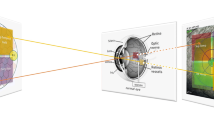Abstract
Objective
To assess the role of multifocal electroretinograms (mfERGs) and optical coherence tomography (OCT) for detecting early changes in macular functions of patients with nasopharyngeal carcinoma (NPC) after radiotherapy.
Methods
mfERGs and OCT were used to examine a NPC group (36 NPC patients after radiotherapy without clinically visible radiation retinopathy, 36 eyes) and a normal control group (25 healthy individuals, 25 eyes) with the same procedure and parameters. The two groups of mfERG were summarized by calculating ring averages, response density, N1 amplitude and P1 and N1 latencies were analysed. OCT scan thickness was summarized into ETDRS regions for comparison.
Results
Compared with controls, the NPC group had significantly decreased P1 response densities in 1–4 ring regions and N1 amplitudes in 1–3 rings (P < 0.01). P1 latencies were obviously prolonged in rings 1 (P < 0.01). In four quadrants (inferonasal, superonasal, inferotemporal and superotemporal) of the mfERG response waveforms, the NPC group had significantly decreased P1 response densities and N1 amplitudes mainly in the inferonasal and inferotemporal quadrants, showing statistically significant differences from the control group (P < 0.0125). But for the OCT results, there is no statistically significant difference between the NPC group and the control group.
Conclusions
In NPC patients after radiotherapy, there may be changes in the mfERGs before any visible fundus lesions appeared as radiation macular oedema. Since the global OCT macular thickness analysis cannot reveal early changes, the mfERGs can objectively and quantitatively assess the earlier changes in macular function in NPC patients.



Similar content being viewed by others
References
Wei KR, Zheng RS, Zhang SW et al (2014) Nasopharyngeal carcinoma incidence and mortality in China in 2010. Chin J Cancer 33(8):381–387
Yi JL, Huang XD, Gao L et al (2006) Nasopharyngeal carcinoma treated by radical radiotherapy alone: ten-year experience of a single institution. Int J Radiat Oncol Biol Phys 65(1):161–168
Lessell S (2004) Friendly fire: neurogenic visual loss from radiation therapy. J Neuroophthalmol 24(3):243–250
Brown GC, Shields JA, Sanborn G et al (1982) Radiation optic neuropathy. Ophthalmology 89:1489–1493
Archer DB, Amoaku WM, Gardiner TA (1991) Radiation retinopathy: clinical, histo- pathological, ultrastructural and experimental correlations. Eye (London) 5:239–251
Sutter EE, Tran D (1992) The field topography of ERG components in man–I. The photopic luminance response. Vis Res 32(3):433–446
Horgan N, Shields CL, Mashayekhi A, Shields JA (2010) Classification and treatment of radiation maculopathy. Curr Opin Ophthalmol 21:233–238
Archer DB, Amoaku WM, Gardiner TA (1991) Radiation retinopathy-clinical, histopathological, ultrastructural and experimental correlations. Eye (London) 5(Pt 2):239–251
Irvine AR, Alvarado JA, Wara WM et al (1981) Radiation retinopathy: an experimental model for the ischemic–proliferative retinopathies. Trans Am Ophthalmol Soc 79:103–122
Reichstein D (2015) Current treatments and preventive strategies for radiation retinopathy. Curr Opin Ophthalmol 26:157–166
Greenstein VC, Holopigian K, Hood DC et al (2000) The nature and extent of retinal dysfunction associated with diabetic macular edema. Invest Ophthalmol Vis Sci 41(11):3643–3654
Xu J, Xu G, Huang T et al (2006) Using multifocal ERG response to discriminate diabetic retinopathy. Doc Ophthalmol 112:201–207
Yu MZ, Zhang X, Zhong XW et al (2000) Quantitative analysis of the diabetic retinopathy with multifocal electroretinogram. Chin J Ocular Fundus Dis 03:185
Shah NV, Houston SK, Markoe AM et al (2012) Early SD-OCT diagnosis followed by prompt treatment of radiation maculopathy using intravitreal bevacizumab maintains functional visual acuity. Clin Ophthalmol 6:1739–1748
Horgan N, Shields CL, Mashayekhi A et al (2008) Early macular morphological changes following plaque radiotherapy for uvealmelanoma. Retina 28(2):263–273
Hood DC, Bach M, Brigell M et al (2012) ISCEV standard for clinical multifocal electroretinography (mfERG) (2011 edition). Doc Opthalmol 124:1–13
Kondo M, Miyake Y, Horiguchi M et al (1995) Clinical evaluation of multifocal electroretinogram. Invest Ophthalmol Vis Sci 36(10):2146–2150
Raman R, Pal SS, Krishnan T et al (2010) High-resolution optical coherence tomography correlates in ischemic radiation retinopathy. Cutan Ocul Toxicol 29(1):57–61
Author information
Authors and Affiliations
Corresponding author
Ethics declarations
Conflict of interest
All authors certify that they have no affiliations with or involvement in any organization or entity with any financial interest or non-financial interest in the subject matter or materials discussed in this manuscript.
Ethical approval
All procedures performed in studies involving human participants were in accordance with the ethical standards of the institutional and national research committees and with the 1964 Helsinki Declaration and its later amendments or comparable ethical standards.
Informed consent
Informed consent was obtained from all individual participants included in the study.
Additional information
Publisher's Note
Springer Nature remains neutral with regard to jurisdictional claims in published maps and institutional affiliations.
Electronic supplementary material
Below is the link to the electronic supplementary material.
Rights and permissions
About this article
Cite this article
Gong, H., Tang, Y., Xiao, J. et al. Evaluation of early changes of macular function and morphology by multifocal electroretinograms in patients with nasopharyngeal carcinoma after radiotherapy. Doc Ophthalmol 138, 137–145 (2019). https://doi.org/10.1007/s10633-019-09678-7
Received:
Accepted:
Published:
Issue Date:
DOI: https://doi.org/10.1007/s10633-019-09678-7




